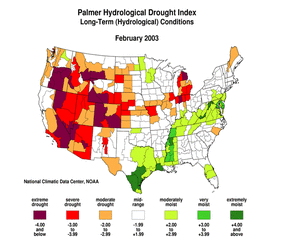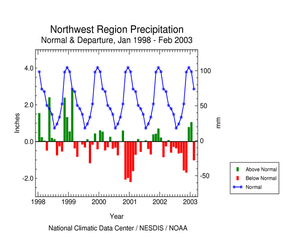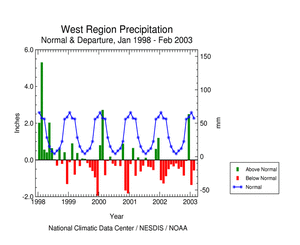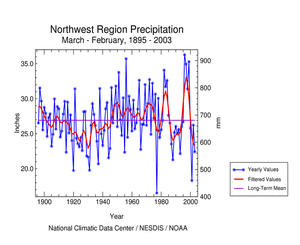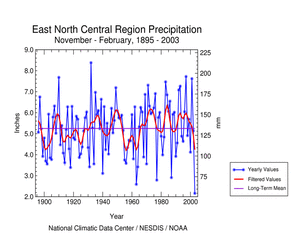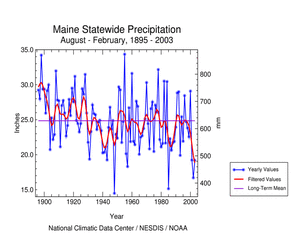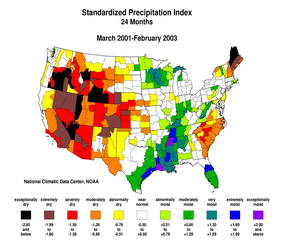U.S. Drought Highlights:
- On the national scale, severe to extreme drought affected about 18 percent of the contiguous United States as of the end of February 2003
- moderate to extreme drought affected about 34 percent of the contiguous U.S.
- Short-term conditions continued dry across much of the Great Lakes to central and northern Great Plains, and February marked a return to dry conditions across much of the West Coast
- Long-term moisture deficits persisted across much of the western U.S., from the central Plains to Great Lakes, and across parts of Maine
Please Note: The data presented in this drought report are preliminary. Ranks, anomalies, and percent areas may change as more complete data are received and processed.
National Overview
On the national scale,
- about 34 percent of the contiguous U.S. fell in the moderate to extreme drought categories (based on the Palmer Drought Index) at the end of February;
- severe to extreme drought affected about 18 percent of the contiguous United States as of the end of February 2003, a decrease of about 7 percent compared to last month owing to above-normal precipitation falling across many of last month's drought areas;
- the coverage of the current (November 1999-present) national-scale drought first peaked in August 2000 at about 36% of the contiguous U.S. (in the severe to extreme categories), which was as extensive as the major droughts of the last 40 years, but not as large as the "dust bowl" droughts of the 1930s and 1950s;
- the total drought area decreased to about 10 percent by November 2000, but had a general increasing trend for much of the period since then, reaching in July 2002 the peak it had first reached in August 2000; there has been a generally decreasing trend in drought area since July 2002 (see graph below left);
- on a broad scale, the last two decades were characterized by unusual wetness with short periods of extensive droughts, whereas the 1930s and 1950s were characterized by prolonged periods of extensive droughts with little wetness (see graph below right);
- although various parts of the U.S. have experienced unusually wet conditions during the last 40 months, little change occurred in the aggregate national wetness picture during much of this period;
- the percentage of the nation severely wet has remained below about eleven percent during this period, dropping to about 3 percent by the end of February 2003 (see graph below left);
- a file containing the national monthly percent area severely dry and wet from 1900 to present is available;
- historical temperature, precipitation, and Palmer drought data from 1895 to present for climate divisions, states, and regions in the contiguous U.S. are available at the Climate Division: Temperature-Precipitation-Drought Data page in files having names that start with "drd964x" and ending with "txt" (without the quotes).
Although some areas of the country were dry this month, much of the U.S. was wet. Integrated across the nation, February 2003 precipitation averaged well above normal, ranking as the 21st driest February in the 1895-2003 record. But the near-record dry January pulls the January - February 2003 rank down to 18th driest.
Regional Overview
- Above-normal precipitation fell across many drought areas during February 2003, but others received below-normal precipitation.
- Much of the Great Lakes to northern Plains region had a fourth consecutive dry month.
- The Pacific Northwest saw a return to drier than normal conditions this month after a two-month wet reprieve.
- The stations in southeastern Alaska were drier than normal this month, but the rest of the stations were generally wet. Unusually warm February temperatures across the state caused more precipitation to fall as rain rather than snow, resulting in a much below-normal snowpack over much of the state. This resulted in Iditarod Trail Sled Dog Race officials approving a detour because of a lack of snow on the normal route, the first time in the history of the race.
- The precipitation pattern at the primary stations in Hawaii and Puerto Rico was mixed.
- The persistent short-term dryness across the Great Lakes to Great Plains compounded drought conditions in that region, while long-term drought continued across much of the West. Several states had the driest December-February or November-February in the 109-year record this year.
- February saw a return to wet conditions across much of the east coast, with long-term deficits mostly erased. Exceptions include Maine, which has experienced dry conditions on both the short-term and long-term timescales, and the Carolinas and Georgia, where moisture deficits continued at only the 24-month timescale.
The long-term dryness is also evident in the pattern of snowfall anomalies. Season-to-date (July 1, 2002 - February 28, 2003) snowfall has totaled below the long-term average across much of the Far West, Great Plains, Great Lakes, and northern New England regions.
Western U.S. Drought
February marked a return to drier-than-normal conditions for the Pacific Northwest after two above-normal months. The West region experienced a second consecutive drier-than-normal month. With the exception of a wet December and near-normal November, every month since January 2002 averaged drier-than-normal for the West region. February was unusually wet for the Southwest region and parts of the central and northern Rockies.
However, long-term deficits remained for much of the West, with several states ranking in the top ten driest category for March 2002-February 2003. Moderate to extreme drought still covered about two-thirds of the western U.S. (Rocky Mountains to west coast) at the end of February. These long-term drought conditions were reflected in below-average snow cover as monitored by snow course measurements, mountain SNOTEL station reports, and satellite observations, as well as by low reservoirs. The winter mountain snowpack is the source of spring meltwater which fills western reservoirs and is used for irrigation during the spring and summer growing seasons. As noted by the USDA Natural Resources Conservation Service, the below-average snowpack is expected to result in below-average streamflow during the spring and summer.
Central U.S. Drought
Although parts of the North Central U.S. received precipitation during February, much of the area from the Great Lakes to the northern Plains had a drier than average month. This month marked the fourth consecutive dry month for the East North Central region, which experienced the driest November-February on record. Several North Central states had the driest November-February or driest winter (December-February) on record.
The dryness has significantly depleted soil moisture from the central Plains to the Great Lakes. This is evident in modeled soil moisture departures as computed by the NOAA Climate Prediction Center and the Midwest Regional Climate Center at both the top soil layers and deeper layers.
February precipitation was near-normal when averaged across the West North Central region. However, the last four months gave the region a rank of fifth driest November-February and the long-term deficits rank March-February as the tenth driest such 12-month period.
Media reports (CNN.com) have illustrated the impact of the drought:
- Ranchers from the Dakotas to Kansas are selling their cattle because they cannot feed them. Some grain farmers could do nothing but watch as the drought dried up their crops.
- Nebraska has seen its driest period since the Dust Bowl days of the 1930s, and the state's economy lost an estimated $600 million on crops, hay, pastures and ranges last year. Some farmers and ranchers are facing their third or fourth year of drought.
Eastern U.S. Drought
This month saw a return to wet conditions across much of the eastern U.S., with only a few pockets of drought remaining. February averaged near normal across Maine, but dryness in both the short- and long-term gave the state the eighth driest January-February, fifth driest August-February, and 25th driest March-February in the 109-year record. Long-term moisture deficits remained over the Carolinas and Georgia at the 24-month timescale.
 NOAA's National Centers for Environmental Information
NOAA's National Centers for Environmental Information

